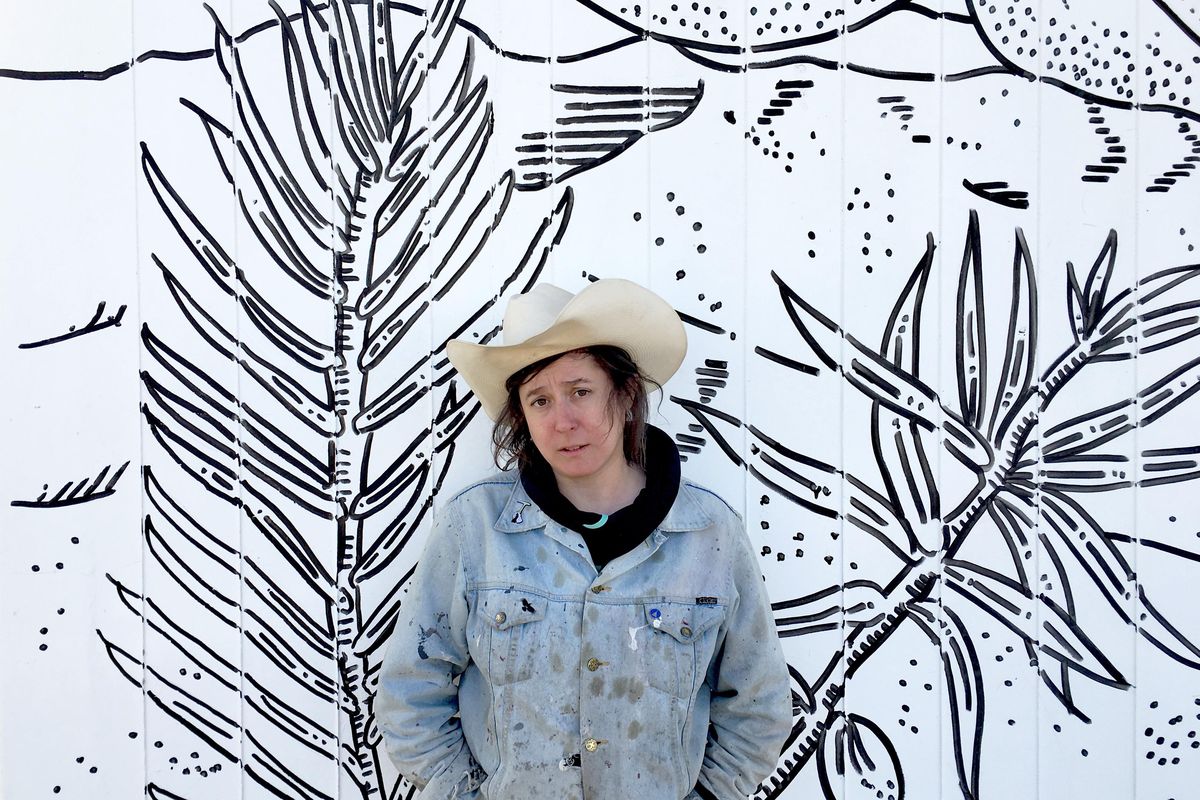Getting There: Artists-in-residence explore what defines Washington transportation
Mary Welcome was chosen as one the Washington State Department of Transportation’s first artists-in-residence. She lives in Palouse, Washington. (Courtesy WSDOT)
The state’s transportation system is one of the more complex networks to fathom. Highly engineered roadways must interact with intricately scheduled transit systems, which must connect with a vast plexus of walkways and bikeways, all of which have to work 24 hours a day, every day of the year.
It’s a machine of machines. So why not hire an artist or two to make sense of it all?
Last week, the Washington State Department of Transportation announced that it had picked its inaugural team of artists-in-residence, who will spend the next year looking for creative ways to communicate what the agency does.
Mary Welcome, who lives in Eastern Washington, and Kelly Gregory, who lives on the West Side of the state, comprise the two-person team that will devise ways to advance the agency’s “strategic plan goals of inclusion, practical solutions and workforce development.”
Welcome and Gregory have done this before, and bring years of experience “working with non-art agencies on creative projects,” Welcome said from her home in the town of Palouse, where she’s lived for 13 years. With their art collective Homeboat, the two recently spent three years in St. James, Minnesota, helping to improve and get people into affordable and safe housing.
Welcome also once worked with a public health organization, where she did portraits of and interviews with people about how they got around in the community, which ended with a public art exhibition.
“We do have a very expansive idea of what public art can look like,” she said. “The door is really quite wide open.”
Welcome said it was far too early to tell what sort of creative product would emerge over the next year. Once the residency officially begins in July, the two artists will spend four months doing “interviews and deep learning” with various WSDOT divisions and employees, like snowplow drivers and ferry captains.
They’ll then propose projects to the agency that will address WSDOT’s larger goals of “improving community engagement, supporting alternatives to driving with only one person per vehicle, creating healthier communities and enhancing safety and equity.”
Before anyone gets too bent out of shape about spending pothole and highway money on art, know that it’s being funded by a $125,000 grant from ArtPlace America, a 10-year collaboration between numerous foundations, federal agencies and financial institutions. The grant will supply a $40,000 stipend split between the two artists, and another $25,000 will go toward whatever final project, or projects, they develop.
Welcome and Gregory were chosen from 30 applicants, said Ben Stone, director of arts and culture for Smart Growth America.
Though cities have had artists-in-residence, this is the first statewide program of its kind, and it was created by ArtPlace America and Transportation for America, a program of Smart Growth America. WSDOT will provide a workspace in Olympia and help coordinate work between the artists and its employees.
Barbara LaBoe, a WSDOT spokeswoman, said the point of the program was to bring a fresh and completely different set of eyes to the agency.
“We have a lot of engineers at our agency and we can certainly benefit from finding a different way of looking at things,” she said.
LaBoe envisioned the final product as anywhere between “traditional public art, or they found a barrier for people using public transit.”
Whatever it is, Welcome said she’s looking forward to learning all about the state’s vast and complex transportation network.
“I’m familiar with the roads and the highways and the construction and clearing the passes. I’m really thrilled to get to learn the huge breadth of transportation issues and modes of transportation” in Washington, she said. “I get to learn how the state connects.”
Tick tock, change those tires
March 31 is the deadline to remove studded tires.
At the strike of midnight on Monday, April 1, motorists with studded tires could receive a $136 fine.
Every year, studded tires cause about $24.5 million in damage to Washington’s roads and highways, according to WSDOT. On top of that, stud-free winter tires perform better than studs in all winter conditions except for “glare ice,” which occurs about 1 percent of the time in the Spokane area.
Millennials buy cars, are poor
This just in: Millennials spend less on cars than people older than them.
This less-than-surprising news that younger people are choosing cheaper cars than other generations – such as Boomers, Gen X-ers, the Greatest Generation, the Silent Generation, the Ys, the Zs, the One Percent and, let’s face it, actual babies – surely has nothing do with them being the youngest and least paid of the income-earning generations.
Nope. According to QuoteWizard.com, millennials drive “cheaper sedans over the more popular SUVs and trucks of their elder generations” because they live in cities and prefer “public transit, ridesharing services, or the dangerous electric scooter.”
According to Pew Research, the median adjusted income in millennial-headed households is $69,700. The median income in households headed by those laconic slackers of Generation X is $77,600. And for homes headed by those hippies-turned-stockbrokers of the Baby Boom, the median income is $85,800.
This translates to millennials still buying cars, but paying about $5,000 less for them. The top three cars purchased by people between the ages of 22 and 37 are Honda Accords and Civics and Nissan Altimas.
3.28 feet of freeway
A Romanian man built exactly one meter of roadway in an attempt to embarrass his nation into building more roads, according to the BBC.
Stefan Mandachi, 33, owns a chain of fast food stores in the Eastern European country and built the small stretch of road, which is as wide as a typical highway but just very short, for 4,400 euros, or about $5,000.
Despite being similar in size to the UK, Romania has the shortest highway system in the European Union, amounting to about 500 miles. Spain has the longest, with more than 9,600 miles. By comparison, the National Highway System in the U.S. has 164,000 miles of roadway.
Romania also has the the highest rate of road deaths in the European Union. In 2017, the rate reached 98 deaths per one million people, double the EU average, according to the BBC. The U.S. rate surpasses Romania’s rate, with 114 deaths per one million people, with a total of 37,133 people killed in motor vehicle crashes in the U.S. in 2017, according to the National Highway Traffic Safety Commission.
According to the BBC, Mandachi spoke next to a road jammed with several hundred supporters who turned out for the “so-called motorway inauguration.” A small plane with a banner demanding more freeways flew in the sky.
“I feel that we are united,” Mandachi said amid a chorus of honking horns in the town of Suceava. “I’ve never lived through a moment of such solidarity amongst all Romanians.”
Mandachi was about four years old when revolution overthrew the government of the Socialist Republic of Romania, part of the wave of revolutions in 1989 marking the end of communist rule in Central and Eastern Europe.

